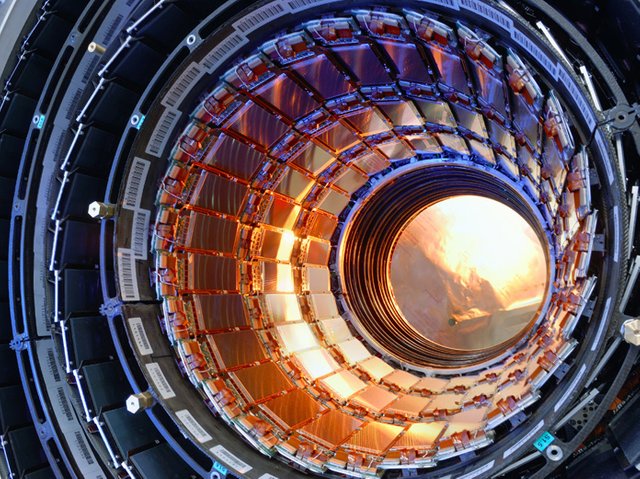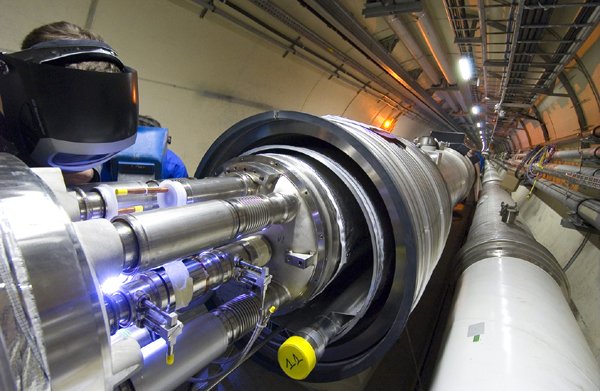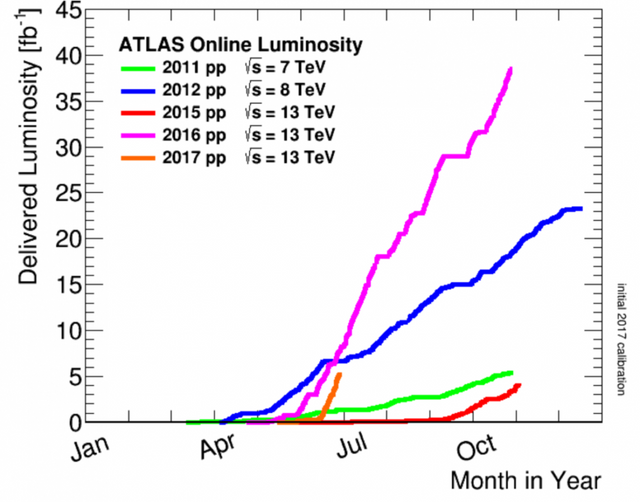Live from CERN - already three world records for the LHC in 2017
Almost exactly 5 years ago, the ATLAS and CMS experiments running around the CERN Large Hadron were announcing the discovery of the Higgs boson, the only missing ingredient (at that time) of the Standard Model of particle physics.
Now, we are five years later; the machine has restarted exactly one week ago (last Wednesday, on June 28th), and it is amazing to see that three world records have been already obtained in less than 10 days.

[image credits: CERN]
After the 2016-2017 winter shutdown, the machine has finally been prepared for new collisions.
This was in particular necessary as the LHC tunnel had been opened for maintenance, breaking the vacuum that is needed inside the machine.
Last Wednesday, on June 28th, the first 2017 collisions have finally been recorded: two beams of protons have been injected into the LHC machine, and there were proton collisions!
TOWARDS THE FIRST 2017 COLLISIONS
The preparation of the LHC for the 2017 collisions was achieved a few weeks ago, with the treatment of the potential electron clouds lying inside the machine.
As I mentioned it on this older post, the walls of the LHC ring have been covered by electrons and gas molecules (known as electron clouds) as a result of the opening if the machine during its shutdown. And this opening was of couse not avoidable for technical and maintenance operations.

[image credits: LHC-outreach @ CERN]
As those electron clouds could destabilize the beams, it was important to treat them before any collision to occur, which was achieved last June.
Subsequently, the machine was ready for the next steps and, not surprizingly, the first 2017 collisions have been recorded 7 days ago! Almost 5 years day by day after the discovery of the Higgs boson!
And in one single week, the LHC managed to surpass three world record in terms of the performance of all particle physics colliders ever built by humans.
RECORD 1: ENERGY IN A BEAM
As detailed in my last LHC post, the proton beams circulating in the LHC tunnel are made of bunches well separated from each other.
With the collisions of last week, the beams included 2556 bunches separated by 25 nanoseconds each. This is a new world record. As this is a bit complicated to visualize, let us convert this number in terms of energy. This is easy to do as a bunch contains 115 billions of protons whose energy is 6.5 TeV each.
This means that the entire beam has an energy of 300 MJ (megajoules). And we have two of those guys. In layman terms, it is as much energy as what is needed to send 10kg of matter outside the Earth gravitational field, or half what is needed by a 100-ton Boeing to fly at full speed.
This record may be surpassed in a close future. However, beams cannot become denser and denser, as at some point, we must be careful to avoid having them damaging the machine.
RECORD 2: PEAK LUMINOSITY
The first record registered by the machine last weeks concerns the peak luminosity that reached a value of 1.58 x 1034 cm-2 s-1. This beats the 2016 record by about 10% and surpasses the design value by more than a factor of 50%.
But what is this strange quantity? And what are the funny units attached to it? Let us start by making a long story short.
In a nutshell, the luminosity of the LHC is its collision rate, or in other words the amount of useful interactions occurring per second. It definitely consists of one of the key quantities describing the performance of any accelerator.

[image credits: ATLAS @ CERN]
In order to understand the units of this quantity (the cm-2 s-1 are standard), one must come back to the notion of cross section. Yep, another big word, on which I will again spend a few seconds.
The cross section is a surface and is thus measured, for instance, in cm2. It exactly corresponds to the area in which two particles must lie in order to be able to interact with each other.
It is easier to visualize this as soon as we consider particles as spheres, so that the cross section is simply related to the size of the spheres and how close they are to each other. If we have a contact between the spheres, we have an interaction.
Of course, this is just illustrative as particles cannot really be considered spheres. But this is the idea.
Let us go back to the topic. The luminosity is the number of useful collisions per unit of time, or the number of collisions per second, that we however evaluate relatively to the cross section. It is then very convenient to deduce the collision rate corresponding to a process of interest: we take the product of the luminosity by the cross section associated to this specific process.
RECORD 3: INTEGRATED LUMINOSITY
The luminosity can also be integrated over a given period of time. That is roughly speaking the amount of useful collisions for a given period of time, like a day or a year.
Multiplying this by a cross section, we get the number of collisions in which a given process has occurred. I have not said it so far, but once the physics theory is fixed, cross sections can be theoretically calculated (and this is not too complicated), so that predictions about the observation of certain classes of processes can be made.
The LHC has collected 0.7 fb-1 in 24 hours, and 6 fb-1 since the first 2017 collisions on June 28th. Those numbers may sound strange, as integrating a luminosity given in cm-2 s-1 over time should leads to cm-2 and not to this crazy new unit I have just introduced.

[image credits: CERN]
The trick is that 1 fb-1 is simply 1039 cm-2, which allows us to get rid of many zeros lying around. ;)
All of this is illustrated on the figure to the left, where the integrated luminosity of the LHC is given year by year.
One observes that 2017 (in orange) is doing already better than 2011 (green) and 2015 (red), and that the slope of the curve is promising to beat 2016 (purple).
45 fb-1 are indeed expected for this year. Which will double the amount of data collected so far during the second run of the LHC.
SUMMARY AND REFERENCES
It is now one week that the LHC has restarted to collide very energetic protons. In one week, the machine managed to break 3 world records in particle physics: the luminosity per second, the luminosity over a day and the energy stored inside a beam.
I have also used this post as an excuse to briefly explain what a luminosity is and what a cross section is. Some physics mixed with some fresh news is always good!
For more information, please have a look to:
interesting, science and technology is most interested post. :)
Lemouth, Are you back in Geneva?
I will spend a week at CERN at the end of October. I don't think I will have the time to go there before (my travel agenda is already realllllyyyyyy full) :)
PS: I am not based in Geneva anymore since the end of 2014 ;)
Although most of what happens there is way over my head, I still am very fascinated by the whole idea of these experiments
:)
Just realised I can use your posts to help with getting my Physics degree! Great content.
That's great! I am happy to see they are helpful :)
Wow new record !
With the collisions of last week, the beams included 2556 bunches separated by 25 nanoseconds each. This is a new world record. As this is a bit complicated to visualize, let us convert this number in terms of energy. This is easy to do as a bunch contains 115 billions of protons whose energy is 6.5 TeV each.
you can actually say new records (plural) :p
@lemouth
Good Job!
Keep posting!
Thanks
interesante